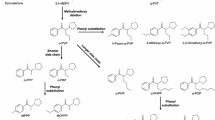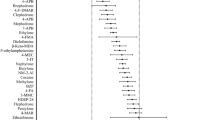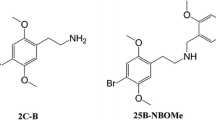Abstract
New groups of synthetic “designer drugs” have increased in popularity over the past several years. These products mimic the euphoric effects of other well-known illicit drugs but are advertised as “legal” highs and are sold over the internet, at raves and night clubs, and in head shops. The 2C series drugs are ring-substituted phenethylamines that belong to a group of designer agents similar in structure to 3,4-methylenedioxy-N-methylamphetamine (MDMA, Ecstasy). Understanding the pharmacology and toxicology of these agents is essential in order to provide the best medical care for these patients. This review focuses on the pharmacology, pharmacokinetics, clinical effects, and treatment of 2C drug intoxication based on available published literature. Multiple names under which 2C drugs are sold were identified and tabulated. Common features identified in patients intoxicated with 2Cs included hallucinations, agitation, aggression, violence, dysphoria, hypertension, tachycardia, seizures, and hyperthermia. Patients may exhibit sympathomimetic symptoms or symptoms consistent with serotonin toxicity, but an excited delirium presentation seems to be consistent amongst deaths attributed to 2C drugs; at least five deaths have been reported in the literature in patients intoxicated with 2C drugs. 2C drugs are a group of designer intoxicants, many of which are marketed as legal, but may carry risks that consumers are unaware of. These drugs may be characterized by either serotonergic toxicity or a sympathomimetic toxidrome, but a presentation consistent with excited delirium is consistent amongst the reported 2C-related deaths. Treatment of 2C intoxication is primarily supportive, but immediate action is required in the context of excited delirium, hyperthermia, and seizure activity.

Similar content being viewed by others
References
Drug Enforcement Administration [webpage on the Internet]. Drugs of abuse, 2011 edition. Washington, DC: Drug Enforcement Administration [updated 2012 Jun 20]. Available from: http://www.justice.gov/dea/docs/drugs_of_abuse_2011.pdf. Accessed 12 Feb 2013
Haroz RH, Greenberg MI (2006) New drugs of abuse in North America. Clin Lab Med 26:147–164
Shulgin AT, Shulgin A (1991) PIHKAL: a chemical love story. Transform Press, Berkeley
Erowid[webpage on the Internet]. Erowid 2C-B Vault Basics. Grass Valley, CA; Erowid [updated 2011 Feb 11]. Available from: http://www.erowid.org/chemicals/2cb/2cb_basics.shtml. Accessed 12 Feb 2013
Wikipedia [webpage on the Internet]. 2C (psychedelics). San Francisco, CA; Wikipedia Foundation, Inc. [updated 2012 Nov 27]. Available from: http://en.wikipedia.org/wiki/2C_%28psychedelics%29. Accessed 12 Feb 2013
National Drug Intelligence Center [webpage on the Internet]. Information bulletin:2C-B (Nexus) reappears on the club drug scene. Johnstown, PA: National Drug Intelligence Center [updated 2001 May]. Available from: http://www.justice.gov/archive/ndic/pubs0/665/index.htm#Contents. Accessed 12 Feb 2013
Drug Enforcement Administration [webpage on the Internet]. 4-bromo-2,5-dimethoxyphenethylamine information sheet. Washington, DC: Drug Enforcement Administration [updated 2011 Feb 16]. Available from: http://www.deadiversion.usdoj.gov/drugs_concern/bromo_dmp/bromo_dmp.pdf. Accessed 12 Feb 2013
European Monitoring Centre for Drugs and Drug Addiction [webpage on the Internet]. 2009 annual report on the state of the drugs problem in Europe. Lisbon: European Monitoring Centre for Drugs and Drug Addiction [updated 2009 Nov 3] Available from: http://www.emcdda.europa.eu/attachements.cfm/att_93236_EN_EMCDDA_AR2009_EN.pdf. Accessed 12 Feb 2013
Drug Enforcement Administration [webpage on the Internet]. 4-iodo-2,5-dimethoxyphenethylamine information sheet. Washington, DC: Drug Enforcement Administration [updated 2011 Aug 5]. Available from: http://www.deadiversion.usdoj.gov/drugs_concern/2c_i.pdf. Accessed 12 Feb 2013
Office of Diversion Control [webpage on the Internet]. Drugs and chemicals of concern. Washington, DC: Drug Enforcement Administration [updated 2013 Jan 24] Available from: http://www.deadiversion.usdoj.gov/drugs_concern/index.html. Accessed 12 Feb 2013
112th Congress [webpage on the Internet]. S. 3187: Food and Drug Administration Safety and Innovation Act. Section 1152. Washington, DC: Library of Congress [updated 2012 Jul 10]. Available from: http://beta.congress.gov/bill/112th-congress/senate-bill/3187. Accessed 12 Feb 2013
Sanders B, Lankenau SE, Bloom JJ, Hathazi D (2008) Research chemicals: tryptamine and phenethylamine use among high-risk youths. Subst Use Misuse 43:389–402
Johnson MP, Mathis CA, Shulgin AT, Hoffman AJ, Nichols DE (1990) [1251]-2-(2,5-dimethoxy-4-iodophenyl)aminoethane ([1251]-2C-I) as a label for the 5-HT2 receptor in rat frontal cortex. Pharmacol Biochem Behav 35:211–217
Villalobos CA, Bull P, Saez P, Cassels BK, Huidobro-Toro JP (2004) 4-bromo-2,5-dimethoxyphenethylamine (2C-B) and structurally related phenylethylamines are potent 5-HT2A receptor antagonists in Xenopus laevis oocytes. Br J Pharmacol 141:1167–1174
Maurer HH (2010) Chemistry, pharmacology, and metabolism of emerging drugs of abuse. Ther Drug Monit 32:544–549
Monte AP, Marona-Lewicka D, Parker MA, Wainscott DB, Nelson DL, Nichols DE (1996) Dihydrobenzofuran analogues of hallucinogens. Models of 4-substituted (2,5-dimethoxyphenyl) alkylamine derivatives with rigified methoxy groups. J Med Chem 39:2953–2961
Drug Enforcement Administration [webpage on the Internet]. 2,5-dimethoxy-4-(n)-propylthiophenethylamine information sheet. Washington, DC: Drug Enforcement Administration [updated 2011 Feb 16; cited 2013 Feb 12] Available from: http://www.deadiversion.usdoj.gov/drugs_concern/2ct7.pdf
Carmo H, Hengstler JG, de Boer D, Ringel M, Remião F, Carvalho F, Fernandes E, dos Reys LA, Oesch F, de Lourdes Bastos M (2005) Metabolic pathways of 4-bromo-2,5-dimethoxyphenethylamine (2C-B): analysis of phase I metabolism with hepatocytes of six species including human. Toxicology 206:75–89
Davies S, Wood DM, Smith G, Smith G, Button J, Ramsey J, Archer R, Holt DW, Dargan PI (2010) Purchasing “legal highs” on the internet—is there consistency in what you get? Q J Med 103:489–493
Meyer MR, Maurer HH (2010) Metabolism of designer drugs of abuse: an updated review. Curr Drug Metabolism 11:468–482
Theobald DS, Putz M, Schneider E et al (2006) New designer drug 4-iodo-2,5-dimethoxy-beta-phenethylamine (2C-I): studies on its metabolism and toxicological detection in rat urine using gas chromatographic/mass spectrometric and capillary electrophoretic/mass spectrometric techniques. J Mass Spectr 41:872–886
Theobald DS, Maurer HH (2007) Identification of monoamine oxidase and cytochrome P450 isoenzymes involved in the deanimation of phenethylamine-derived designer drugs (2C-series). Biochem Pharmacol 73:287–297
Cole MD, Lea C, Oxley N (2002) 4-bromo-2,5-dimethoxyphenethylamine (2C-B): a review of public domain literature. Sci Justice 42:223–224
Nagai F, Nonaka R, Hisashi S, Kamimura K (2007) The effects of non-medically used psychoactive drugs on monoamine neurotransmission in rat brain. Eur J Pharmacol 559:132–137
Vilke GM, DeBard ML, Chan TC et al (2012) Excited delirium syndrome (ExDS): defining based on a review of the literature. J Emerg Med 43:897–905
Hoffman L. ACEP Recognizes excited Delirium Syndrome. EMNOW’s ACEP Scientific Assembly Edition: October 2009
Mash DC, Pablo J, Ouyang Q et al (2002) Dopamine transport function is elevated in cocaine users. J Neurochem 7:2564–2571
Stephens BG, Jentzen JM, Karch S et al (2004) Criteria for the interpretation of cocaine levels human biological samples and their relation to the cause of death. Am J Forensic Med Pathol 25:1–10
Staley JK, Talbot JZ, Ciliax BJ et al (1997) Radioligand binding and immunoautoradiographic evidence for lack of toxicity to dopaminergic nerve terminals in human cocaine overdose victims. Brain Res 747(2):219–229
Little KY, McLaughlin DP, Zhang L et al (1998) Brain dopamine transporter messenger RNA and binding sites in cocaine users: a postmortem study. Arch Gen Psychiatry 55:793–799
Wilson JM, Levey AI, Bergeron C, Kalasinsky K, Ang L, Peretti F, Adams VI, Smialek J, Anderson WR, Shannak K, Deck J, Niznik HB, Kish SJ (1996) Striatal dopamine, dopamine transporter, and vesicular monoamine transporter in chronic cocaine users. Ann Neurol 40:428–439
Staley JK, Welti CV, Ruttenber AJ (1995) Altered dopaminergic synaptic markers in cocaine psychosis and sudden death. NIDA Res Monogr Series 153:491
Schmauss C, Haroutunian V, Davis KL, Davidson M (1993) Selective loss of dopamine D3-type receptor mRNA expression in parietal and motor cortices of patients with chronic schizophrenia. Proc Natl Acad Sci 90:8942–8946
Topeff JM, Ellsworth H, Willhite LA, Bangh SA, Edwards EM, Cole JB (2011) A case series of symptomatic patients, including one fatality, following 2C-E exposure. Clin Toxicol 49:526
Erowid [webpage on the Internet]. A reported 2C-T-7 death. Grass Valley, CA; Erowid [updated 2012 Apr 18]. Available from: http://www.erowid.org/chemicals/2ct7/2ct7_death1.shtml. Accessed 16 Feb 2013
Erowid [webpage on the Internet]. Second reported 2C-T-7 death. Grass Valley, CA; Erowid [updated 2012 Apr 18]. Available from: http://www.erowid.org/chemicals/2ct7/2ct7_death2.shtml. Accessed 16 Feb 2013
Erowid [webpage on the Internet]. Third confirmed 2C-T-7 death. Grass Valley, CA; Erowid [updated 2012 Apr 18]. Available from: http://www.erowid.org/chemicals/2ct7/2ct7_death3.shtml. Accessed 16 Feb 2013
Erowid [webpage on the Internet]. LA man’s death leads to drug arrests. Grass Valley, CA; Erowid [updated 2012 Apr 18]. Available from: http://www.erowid.org/chemicals/2ct21/2ct21_article1.shtml. Accessed 16 Feb 2013
Rupar A [webpage on the Internet]. Adam Budge, 18, charged with murder following friend’s synthetic drug overdose. Minneapolis: City Pages [updated 2012 Jun 21]. Available from: http://blogs.citypages.com/blotter/2012/06/adam_budge_18_charged_with_murder_following_friends_synthetic_drug_overdose.php. Accessed 16 Feb 2013
Walsh P [webpage on the Internet]. U.S. indicts four in synthetic drug deaths. Minneapolis: Star Tribune [updated 2012 Dec 27]. Available from: http://www.startribune.com/printarticle/?id=184934801. Accessed 16 Feb 2013
Chanen D [webpage on the Internet]. Blaine man arrested after overdose at house party. Minneapolis: Star Tribune [updated 2011 Mar 18]. Available from: http://www.startribune.com/local/north/118182584.html. Accessed 12 Feb 2013
Miyajima M, Matsumoto T, Ito S (2008) 2C-T-4 intoxication: acute psychosis caused by a designer drug. Psychiatr Clin Neurosci 62:243
Huang HH, Bai YM (2011) Persistent psychosis after ingestion of a single tablet of ‘2C-B’. Prog Neuro-Psychopharmacol Biol Psychiat 35:293–294
Taylor RL, Maurer J, Tinklenberg JR (1970) Management of “bad trips” in an evolving drug scene. JAMA 214:422
Spain D, Crilly J, Whyte I, Jenner L, Carr V, Baker A (2008) Safety and effectiveness of high-dose midazolam for severe behavioural disturbance in an emergency department with suspected psychostimulant affected patients. Emerg Med Australas 20:112
Nobay F, Simon B, Levitt M, Dresden G (2004) Midazolam versus haloperidol versus lorazepam in the chemical restraint of violent and severely agitated patients. Acad Emerg Med 11:744–749
Vilke GM, Bozeman WP, Dawes DM, DeMers G, Wilson MP (2012) Excited delirium syndrome (ExDs): treatment options and considerations. J For Leg Med 19:117–121
Alexander J, Tharyan P, Adams C, John T, Mol C, Philip J (2004) Rapid tranquillisation of violent or agitated patients in a psychiatric emergency setting. Pragmatic randomised trial of intramuscular lorazepam v. haloperidol plus promethazine. Br J Psychiatry 185:63–69
Battaglia J, Moss S, Rush J, Kang J, Mendoza R, Leedom L, Dubin W, McGlynn C, Goodman L (1997) Haloperidol, lorazepam, or both for psychotic agitation? A multicenter, prospective, double-blind, emergency department study. Am J Emerg Med 15:335–340
Thomas H (1992) Droperidol versus haloperidol for chemical restraint of agitated and combative patients. Ann Emerg Med 21:407–413
Martel M, Sterzinger A, Miner J, Clinton J, Biros M (2005) Management of acute undifferentiated agitation in the Emergency Department: a randomized double-blind trial of droperidol, ziprasidone and midazolam. Acad Emerg Med 12:1167–1172
Burnett AM, Salzman JG, Griffith KR, Kroeger B, Frascone RJ (2012) The Emergency Department experience with prehospital ketamine: a case series of 13 patients. Prehosp Emerg Care 16:1–7
Takeuchi A, Ahern TL, Henderson SO (2011) Excited delirium. West J Emerg Med 12:77–83
Rusyniac DE, Sprague JE (2006) Toxin induced hyperthermic syndromes. Med Clin N Am 2005; 89: 1277–1296. Review. Erratum in: Med Clin North Am 90: 261–2
Author information
Authors and Affiliations
Corresponding author
Rights and permissions
About this article
Cite this article
Dean, B.V., Stellpflug, S.J., Burnett, A.M. et al. 2C or Not 2C: Phenethylamine Designer Drug Review. J. Med. Toxicol. 9, 172–178 (2013). https://doi.org/10.1007/s13181-013-0295-x
Published:
Issue Date:
DOI: https://doi.org/10.1007/s13181-013-0295-x




